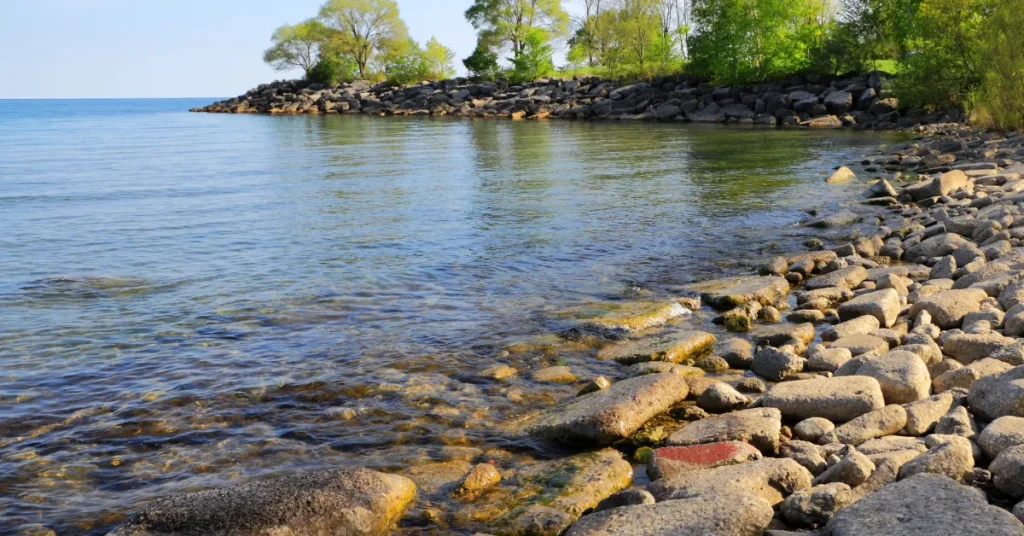Lake Ontario has an average depth of about 86 meters (283 feet). Its maximum depth reaches approximately 244 meters (800 feet).
Nestled amid the Great Lakes of North America, Lake Ontario bears the badge of being the easternmost and smallest in surface area of the five prestigious bodies of water. Boasting a vital role as a freshwater treasure, it serves as a hub for shipping, recreation, and ecology.
Its waters span an area of 18,960 square kilometers (7,340 square miles), holding a staggering volume of 1,640 cubic kilometers (393 cubic miles) of water.
The shores of Lake Ontario, shared by Canada’s Ontario province and the United States’ New York state, capture the fascination of tourists, explorers, and scientists alike, thanks to its mesmerizing depth, historical significance, and rich biodiversity.

Fathoming Lake Ontario’s Depths
Exploring the depths of Lake Ontario leads to a surprising discovery. Beneath its tranquil surface, a deep, dark world exists. It’s a vast underwater terrain, different from any typical lake. This section dives into how deep Lake Ontario really is.
Gauging The Maximum Depth
Understanding Lake Ontario’s deepest point provides a glimpse into its aquatic grandeur. Sonar technology reveals its secret. Experts use it to map the lakebed.
- Maximum depth reached: Approximately 802 feet.
- Average depth: About 283 feet.
These figures confirm Lake Ontario as a deep and complex body of water. Its depths hide mysteries and historical shipwrecks waiting to be explored.
Comparative Depth To Other Great Lakes
Lake Ontario’s depth compared to its siblings tells an interesting story about the Great Lakes. It’s not the deepest, but it holds its own.
| Lake | Maximum Depth (feet) |
| Superior | 1,333 |
| Huron | 750 |
| Michigan | 923 |
| Erie | 210 |
| Ontario | 802 |
Lake Superior holds the record for depth. Yet, Lake Ontario is significantly deeper than Lake Erie. This positioning affects water temperature, ecosystem, and even navigation.
Formation And Characteristics

Lake Ontario, with its vast expanse of blue, holds secrets beneath its waves. The lake’s formation and characteristics offer a rich tapestry of geological history.
Its waters serve as a testament to the natural processes that shaped it. Let’s explore the origins and features that make Lake Ontario remarkable.
Geological Origins And History
The story of Lake Ontario begins thousands of years ago. Born from the last great Ice Age, it owes its existence to glaciers that slowly advanced and retreated, sculpting the land. These ice sheets carved the basin Lake Ontario now fills.
- Glacial activity shaped its foundation.
- The Earth’s crust responded, rebounding once the glaciers melted.
- Over time, waterways connected, filling the chasm to form the lake we see today.
Physical Features And Water Volume
Lake Ontario boasts remarkable traits, from its vast area to the volume of water it contains. These features reveal the lake’s majestic size and depth.
| Feature | Detail |
| Surface area | 18,960 square kilometers |
| Average depth | 86 meters |
| Maximum depth | 244 meters |
| Water volume | 1,640 cubic kilometers |
Its deepest points reach 244 meters, while the lake’s volume is an impressive 1,640 cubic kilometers. The waters of Lake Ontario share their richness with the surrounding landscapes, fueling ecosystems and nurturing diverse species.
Exploring Aquatic Terrain
Exploring Aquatic Terrain plunges us into the heart of Lake Ontario’s mysteries. This lake, one of the five Great Lakes of North America, holds secrets beneath its surface.
Its waters tell stories of geological wonders and historical artifacts, inviting adventurers and scientists alike to uncover its depths. How deep is Lake Ontario? Join us as we navigate its underwater terrain and discover the hidden treasures that lie beneath.
Underwater Terrain And Structures
Lake Ontario’s bottom is as fascinating as its surface is expansive. The lake’s deepest point reaches roughly 244 meters (800 feet). But that’s not all there is to this aquatic landscape.
- Glacial Scars: Ice sheets carved valleys and left ridges.
- Ancient River Beds: Old waterways now lie submerged.
- Sunken Plateaus: Submerged features create diverse habitats.
Explorers can find cliffs plunging into darkness and hills rolling beneath waves. Each structure plays a role in the lake’s ecology and history.
Notable Discoveries Beneath The Surface
The depths of Lake Ontario are a treasure trove for those who seek them. Over time, explorers have made remarkable finds:
- Shipwrecks: Resting places of vessels from bygone eras.
- Lost Cargo: The remains of historic commerce gone awry.
- Unique Ecosystems: Home to rare and endemic species.
These underwater finds not only intrigue historians but also provide crucial insights into the past. The lakebed acts as a time capsule, encapsulating stories of triumph and tragedy.
Whether it’s the awe of geological formations or the thrill of historical discoveries, Lake Ontario’s depths captivate all who dare to delve into its dark waters.
Ecological Significance
Lake Ontario serves as a vital ecological hub. Its depths create unique habitats. These areas are crucial for the survival of diverse species. Let’s explore the lake’s impact on ecology.
Habitats Within The Deep
Lake Ontario’s deep waters hold various habitat types. These range from cold, dark abysses to rocky substrates. They shelter rare aquatic plants and fish species. The deep zones sustain life even with minimal sunlight.
- Coldwater zones: Home to trout and whitefish.
- Deepwater benthic zones: Vital for small invertebrates.
- Submerged shelves: Breeding grounds for bass and walleye.
Impact On Regional Biodiversity
Lake Ontario’s biodiversity thrives thanks to its depths. These areas affect life above and below the surface. They provide food and refuge for many species.
| Zone | Species Protected | Ecological Role |
| Deepwater Trenches | Burbot, Deepwater Sculpin | Sustaining deepwater food chains |
| Nearshore Areas | Perch, Smallmouth Bass | Supporting recreational fishing |
| Wetlands | Amphibians, Waterfowl | Filtering pollutants, nutrient cycling |
Each habitat zone plays a key part. They support complex food webs. The health of Lake Ontario affects countless lives within the region.
Human Encounters And Lore

Over time, Lake Ontario has witnessed countless human endeavors. Its waters hold tales of triumph and tragedy. These stories form a rich tapestry of lore that weaves through the history of the region.
Shipwrecks and historical milestones mark Lake Ontario’s depths, attracting both historians and adventurers alike to its mysterious underwater world.
Historical Significance And Shipwrecks
Lake Ontario’s waters serve as a final resting place for over 200 shipwrecks. These vessels, some dating back to the 18th century, are snapshots of maritime history. The lake’s role in trade, warfare, and migration has assured its position in history books.
- The HMS Ontario, a British warship sunk in 1780, is among the most famous.
- War of 1812 brought battles and blockades to Lake Ontario’s waters.
- Steamers and schooners that once carried passengers and cargo now lie silent.
| Shipwreck Name | Year Sunk | Historical Note |
| HMS Ontario | 1780 | Oldest fully-intact shipwreck in the Great Lakes |
| SS Noronic | 1949 | Deadliest disaster in Toronto’s history |
Modern Exploration And Technological Advances
Advances in technology have transformed how we explore Lake Ontario’s depths. Robotic submersibles and sophisticated sonar enable the discovery and study of submerged secrets.
- Digital imaging provides unprecedented views of shipwrecks.
- New finds bring light to long-forgotten tales of the deep.
- Underwater archaeology flourishes with modern methods.
In recent years, explorers have identified shipwrecks previously lost to time. These discoveries offer glimpses into the lake’s past and inspire future explorations. As diving technology evolves, the waters of Lake Ontario promise more revelations.
Conservation Efforts And Challenges
Lake Ontario’s health is vital to countless species including humans. Challenges in conservation require urgent and effective responses. The vastness of the lake conceals not just water and life, but also the impact of human activity.
Threats To The Lake’s Ecosystem
Lake Ontario’s delicate balance is under siege from numerous fronts. These threats include:
- Water pollution: Industrial waste and urban run-off degrade water quality.
- Invasive species: Zebra mussels and other non-native species disrupt food chains.
- Overfishing: This threat reduces fish populations and alters the ecosystem.
- Climate change: It leads to unpredictable water levels and temperatures.
Initiatives To Protect The Depths
Action is being taken to safeguard the lake. Key initiatives include:
- Regulation enforcement: Stricter laws prevent illegal dumping and overfishing.
- Habitat restoration: Projects aim to restore wetlands and natural shorelines.
- Conservation education: Programs inform the public about sustainable practices.
- Research: Studies monitor health indicators and inform policy decisions.
FAQs About How Deep Is Lake Ontario
What Is The Maximum Depth Of Lake Ontario?
Lake Ontario reaches its greatest depth at about 802 feet (244 meters). This point is nestled in the northeastern portion of the lake, providing a notable feature for this Great Lake.
How Does Lake Ontario’s Depth Compare To Other Great Lakes?
While impressive, Lake Ontario’s maximum depth is moderate compared to its neighboring Great Lakes. Lake Superior holds the record as the deepest, with depths reaching over 1,300 feet (396 meters).
What Is Lake Ontario’s Average Depth?
The average depth of Lake Ontario is approximately 283 feet (86 meters). Its relatively even basin contributes to this average, creating a balanced and navigable body of water.
Why Is Lake Ontario’s Depth Important?
Lake Ontario’s depth influences its water temperature, aquatic life, and maritime activities. Deep waters allow for the habitation of diverse fish species and accommodate large commercial vessels.
Conclusion
Exploring Lake Ontario’s depths reveals much more than mere numbers. With an average depth of around 283 feet and a staggering deepest point at 802 feet, this body of water’s vastness is as impressive as it is significant.
Remember, Lake Ontario is not just a geographical marvel; it’s an integral part of the region’s ecosystem and history.
Whether you’re a seasoned explorer or a curious reader, the lake’s mysteries await your discovery.
Resources:
1. https://www.epa.gov/greatlakes/lake-ontario
